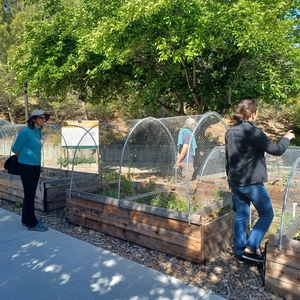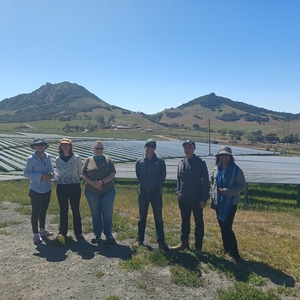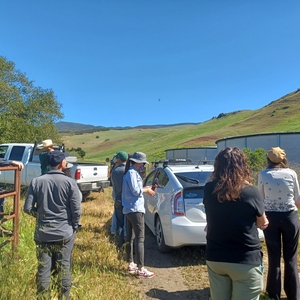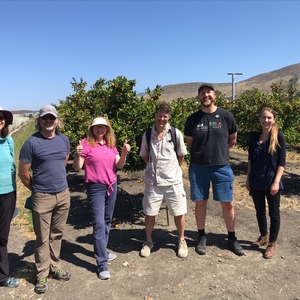CSU Faculty Learning Community in Teaching Climate Change and Resilience
California Polytechnic State University, California State University, Chico, California State University, Monterey Bay, California State University, San Marcos, California State University, Stanislaus, Cal Poly Humboldt, Strategic Energy Innovations
Project Overview
In the Spring of 2022, 62 faculty from six different California State University campuses representing over 30 disciplines participated in the CSU Faculty Learning Community in Teaching Climate Change and Resilience, the first multi-campus faculty learning community in CSU history. During seven 90-minute sessions spread evenly throughout the semester, participants covered the science behind climate change, the solutions available to counter it, the need to incorporate justice into the conversation and the enormous anxiety all of this produces in our students. The FLC heard from over 20 speakers from inside and outside academia who connected faculty with a broad range of approaches and ideas, as well as resources that were well researched, relevant, and relatable. Lots of resources. Faculty also talked about taking their teaching outside the classroom with discussions on civic engagement and the campus as a living lab. By June, over 75 classes spanning all fields of study, from Polymers to Plato, had been redesigned to include greater engagement of climate change and resilience.
Background
The impacts of climate change are getting hard to ignore. This is especially true in California, where wildfires have destroyed entire towns, uprooted families, and disrupted daily life on a year-round basis. University campuses not closed due to a wildfire have had to endure the noxious smoke that has blanketed the state. The immediacy of the impacts led students to begin asking questions about climate change that faculty were not necessarily trained to answer. Responding to these concerns, staff and faculty at CSU, Chico and UC, Santa Barbara created a two-hour Zoom workshop on Climate Change and Resilience in the Classroom that they offered three times during the Spring of 2021. The response was overwhelming and included faculty from other CSUs. Widespread interest led the workshops designers to propose a Faculty Learning Community in Teaching Climate Change and Resilience and to contemplate opening the FLC to other CSU faculty via Zoom.
Separately, CSU Sustainability Officers were collaborating to provide collective programming for their individual campuses. During the 2020-21 academic year, sustainability officers from across the 23-campus California State University (CSU) system, the largest public university system in the U.S., joined forces to coordinate a series of educational and empowering events focused on the themes of climate justice, environmental racism, and intersectional sustainability. During the fall semester, they hosted a multi-campus series, Climate Justice = Social Justice: Conversations Exploring the Intersections of People, Planet & Power. During the spring semester they hosted the CSU’s headline Earth Day event, Taking Action for People and the Planet, featuring four young climate justice activists, environmental educators, and eco-communicators (See Award Finalist case study). When the Chico Team floated a multi-campus FLC, this group of sustainability officers jumped at the opportunity. They found the funding to offer the FLC on their campus and recruited faculty to join.
Goals
- Help faculty integrate climate change and resilience into a current course in a meaningful and equitable way.
- Provide faculty with class materials that are well researched, relevant, and relatable to their discipline.
- Provide faculty with the tools and resources to engage the emotions that young people experience when talking about climate change.
- Provide a place for faculty to reconnect after almost two years of social distancing.
- Create a community of scholars who can continue to support each other after the FLC concludes.
- Support the work of campus sustainability coordinators to meet CSU 2021 Sustainability Policy goals, and to fulfill credit requirements of AASHE STARS.
Implementation
In April of 2021, CSU, Chico Director of Sustainability Cheri Chastain submitted a proposal to President Hutchinson’s Office to fund a Faculty Learning Community on Teaching Climate Change and Resilience for Chico faculty in support of the President’s recently released Strategic Plan. The request included faculty stipends and a teaching assistant. The project was a follow-up to a series of workshops facilitated by Ms. Chastain and CSU, Chico faculty member Dr. Mark Stemen. They worked with their campus Director of Faculty Development, Dr. Chiara Ferrari, to design a seven-session Faculty Learning Community. They submitted the funding proposal to the President’s Office in May and funding was approved in June.
Following funding approval for the Chico campus, Ms. Chastain shared the opportunity with her fellow Sustainability Officers, and they met virtually to plan outreach and seek funding for additional faculty stipends. Dr. Stemen reached out to SEI Executive Director Cyane Dandridge for additional logistical and creative support needed for a systemwide FLC.
Six campuses were able to secure funding (Chico, San Luis Obispo, Humboldt, San Marcos, Stanislaus, and Monterey Bay). The sustainability officers worked with their campus Faculty Development Directors to recruit faculty and arrange for their stipends. To spread the benefits of the FLC further, Ms. Chastain and Dr. Stemen worked with the organizers of the This Way to Sustainability conference at Chico State to provide the conference with a Keynote Speaker and a Panel Discussion. Dr. Tracey Osborne, Director of the University of California’s Center on Climate Justice, gave a virtual Keynote presentation on “Climate Justice in Higher Education.” Dr. Osborne was then joined virtually by five members of the Faculty Learning Community from across the state for a panel discussion on “Climate Justice in the Classroom.”
The FLC met every other week. A typical two-week cycle adopted the following schedule:
Friday: Facilitation team meets virtually to plan the upcoming session
Wednesday: Facilitation team meets virtually with sustainability officers to describe the upcoming session, and then sends a letter to faculty describing the upcoming session.
Friday: Facilitation team meets virtually to finalize session stage notes.
Monday: Facilitation team sends reminder and agenda to faculty.
Wednesday: FLC session (virtual and in-person) from 9:00 – 10:30.
Thursday: All session materials and recordings are uploaded to the drive.
Friday: Facilitation team debriefs the last session and begins preparing for the next one.
**Implementation Partnership ** Facilitation Team: Dr. Mark Stemen, Dr. Elizabeth Bagley, Natalie Pangilinan, Kori Nielsen
Campus Sustainability Officers: Cheri Chastain (Chico), Kylee Singh (Cal Poly), Katie Koscielak (Humboldt), Lacey Raak, (Monterey Bay), Juliana Goodlaw-Morris, (San Marcos), Wendy Olmstead (Stanislaus)
14 FLC Presenters (student, faculty, professional)
CSU Chancellor’s Office of Faculty Development and campus officers
Timeline
May 2021 – Chico Director of Sustainability Cheri Chastain submits the funding proposal to the President’s Office in May and funding is approved in June.
Summer 2021 – Sustainability Officers meet virtually to plan outreach and seek funding for faculty stipends. Natalie Pangilinan is hired as the FLC TA and begins assembling resources for the FLC.
October 2021 – SEI Project Director Dr. Bagley and SEI Climate Corp Fellow Kori Nielson join the “Facilitation Team,” which begins meeting weekly to refine the sessions and invite speakers to present. They begin recruiting CSU faculty members to open each session.
November 2021 – Funding is secured at six campuses (Chico, San Luis Obispo, Humboldt, San Marcos. Stanislaus, Monterey Bay) and faculty recruitment begins.
January 2022 – Faculty recruitment closes with 65 faculty registered. Acceptance letters are sent out by campus sustainability officers, followed by a welcome letter from the Facilitation Team.
February 2022 – Faculty Learning Community begins
February 9: Introductions and Goals
February 23: Science and Solutions
March 9: Class Assignments and Activities
March 23: Global and Civic Engagement
April 6: Climate Justice
April 20: Campus as a Living Climate Lab
May 4: Redesign Presentations
March 26, 2022 – This Way to Sustainability FLC Keynote Dr. Tracey Osborne on “Climate Justice in Higher Education” and Panel Discussion on “Climate Justice in the Classroom.”
May 2022 – FLC concludes
June 2022 – Final Deliverables Due
Financing
*Original Chico Budget: $25,000 ($17K from President, $8K from Sustainability) ** Faculty Lead: $3,500
Student Assistant*: $8000
Faculty Facilitators: (5x$300) = $1,500
Faculty stipends: (20x$500) = $10,000
Resources, miscellaneous, hospitality: $2000
**Cal-Poly SLO: $10,000 ($5K from Center for Teaching, $5K from Sustainability) ** Faculty Stipends
**Cal-Poly Humboldt: $3,000 from Office of the Provost ** Faculty Stipends
**CSU, Stanislaus: $5,000 from Office of the Provost ** Faculty Stipends
**CSU, San Marcos: $3,500 from the Faculty Center ** Faculty Stipends
**CSU, Monterey Bay: $5,000 from Campus Grant Funds ** Faculty Stipends
**SEI: $27,000 from Climate Corps and In-kind Donation ** Climate Corps Fellow = $15,000
Project Director, Elizabeth Bagley = $12,000 (In-kind donation)
**Total budget = $75,500 **
Results
-
This project helped faculty integrate climate change and resilience into over 75 courses in a meaningful and just way. Final deliverables (due June 10th) included a 1-2-minute video describing the changes and connecting them to the FLC and a copy of the revised course syllabus with the changes identified. These videos will be shared with all members of the FLC, the campus sustainability coordinators, and the campus faculty development directors.
-
The seven sessions of the FLC provided faculty with class materials that are well researched, relevant, and relatable to their discipline. Ms. Pangilinan and Ms. Nielsen compiled all the materials from the sessions into a 25+ page resource document available for easy reference and replication. The resource doc is divided between curriculum and articles and other resources, and there is a brief annotation for each entry. It can be viewed here.
-
The FLC provided faculty with the tools and resources to engage the emotions that young people experience when talking about climate change. We need to talk about the solutions more than the problem.
-
The CSU FLC created a community of scholars who can continue to support each other after the FLC concludes. Many campuses created activities outside the FLC, such as informal meals, campus tours, small group meetings in-between FLC sessions, and a book club. We also have tentative plans for a virtual FLC Reunion in the Fall.
-
This project supported the work of campus sustainability coordinators to meet CSU 2022 Sustainability Policy goals, and to fulfill credit requirements of AASHE STARS by revising many courses and having a session focused on Campus as a Living Lab.
Lessons Learned
**In person vs. virtual attendance ** We learned that hosting a large multi-campus faculty learning community is possible over Zoom without losing the key features of an FLC: examination, reflection, collaboration, and connection. We started with the notion of everyone meeting on campus in-person and having those in-person meetings connected via Zoom, but that plan changed when one campus did not reopen and remained entirely virtual. Offering virtual attendance to one campus soon led to calls for virtual attendance from all campuses, and divided campuses with some of the faculty meeting in-person and other faculty joining on Zoom. While we struggled at first, we found the Zoom format allowed for greater collaboration because isolated faculty— “I am the only computer scientist on my campus” —could find peers on other campuses. We found the disciplinary-based breakout rooms to be very popular for this reason. Faculty were also able to network and create campus connections through shared meals (Chico), field trips (SLO), and meetings between our sessions (Stanislaus). In the next round, we would hold the working sessions entirely over Zoom and be very deliberate about scheduling in-person community building activities on each campus between sessions.
**Scheduling ** Less is more for busy faculty. Our 2021 one-day workshops were two hours long and we heard from a few faculty in our exit survey that two hours was still too long. Some felt their attention lagged after 90 minutes, while others had to leave early to make it to their next class scheduled at the top of the hour. We also found faculty more engaged early in the day and during the middle of the week. So, we scheduled our sessions for Wednesday mornings from 9:00-10:30. At 90 minutes, our FLC sessions were shorter than any of the examples we reviewed, and it meant we needed to keep to a tight schedule. While we often felt rushed, we believe the shorter time commitment was one reason we attracted so many participants.
We had seven sessions that met every other week. Our first session was February 9th. Our last session was May 4th. Faculty enthusiasm waned toward the end. We believe we could have offered six sessions, concluded in April, and achieved the same end results.
A multi-campus FLC needs to be aware of different holiday schedules. This FLC was scheduled around the Chico State Spring Break, which caused difficulty at the two campuses with a different holiday schedule.
**A Flipped FLC ** The tight timeline led to the decision to record faculty presentations in advance, in part to ensure the speakers did not run too long. We later heard that faculty appreciated being able to easily watch a presentation again without having to navigate the full session recording. We did not embrace the full flipped classroom because faculty are too busy to watch the videos outside of the session, but the videos’ short length (10min) allowed us to easily integrate them into large discussions. The fast pace and changing modes (video, breakout, Jamboard) also seemed to keep everyone’s attention.
**Something for Everyone ** We had 62 faculty from over 30 disciplines, “from Polymers to Plato,” so we had to make sure we offered a wide range of materials and discussion points. We started each session with art, including paintings, poetry, and song. We had a faculty member share traditional climate change teaching materials from InTeGrate. Others shared curricular material from outside entities including Project Drawdown, The All We Can Save Project, and Solutions Journalism Network. We stretched the topic by having faculty-led discussions on climate emotions and climate justice. The idea was to make sure everyone could find something. The drawback of sharing so much material is that we did not have much time to spend on any of it.
**Climate Anxiety is Real ** In the second session, faculty were asked, “What comes to mind when you think about climate change?” Our results mirrored the nation: 44% listed Outcomes, 18% Causes, 4% Solutions. Students, we learned, desperately want solutions. We heard from our CSU colleague Dr. Sarah Ray about her book, A Field Guide to Climate Anxiety: How to Keep Your Cool on a Warming Planet. A big takeaway from the FLC for many was that climate anxiety in our students is justified, and how we teach about climate change might be making it worse. We need to spend less time talking about the problem, and more time talking about the solutions.
**Climate Justice needs to be our NorthStar ** In addition to the seven sessions, our FLC also reached out to a larger audience. In a pre-recorded Keynote for the This Way to Sustainability Conference, Tracey Osborne from the new UC Center for Climate Justice spoke about Climate Justice in Higher Education. On Friday of the conference, five FLC members joined Tracey for a panel on Climate Justice in Higher Education. From those discussions we learned that the climate crisis cannot be separated from the history that produced it, and if we want to be successful in addressing climate change, climate justice must be our North Star.
**Our colleagues in workforce development have a lot to offer to faculty development ** A Higher Education Partner like SEI, AASHE, or Second Nature can be a great facilitator and platform to bridge the world of research and teaching with industry and civil society. The campus-based members of the facilitation team were able to find faculty who could speak to the science and policy of climate change and resilience, but they appealed to a small slice of the faculty, in the same old ways. Our educational partners at SEI recruited speakers from All We Can Save, Project Drawdown, and the Solution Journalism Network who brought something completely different, and faculty from all fields of study were inspired.





